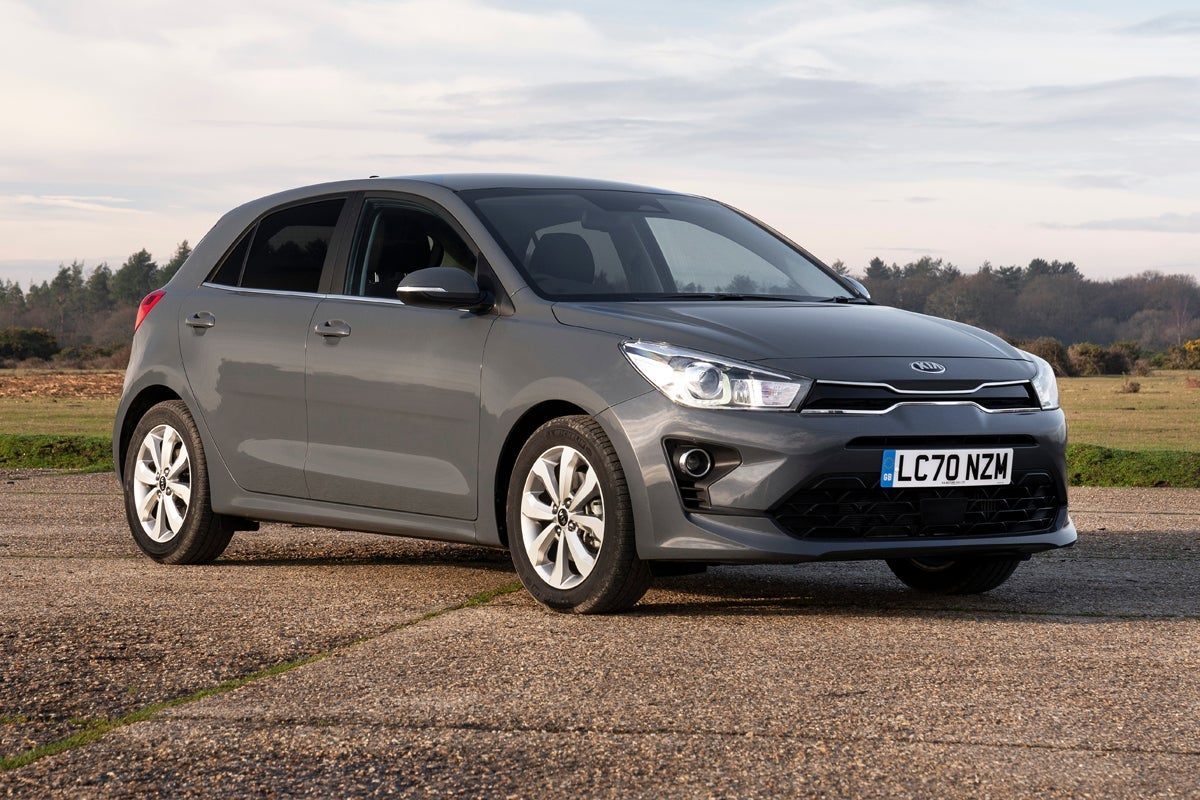Kia Rio Review 2025: Price, specs & boot space
Written by Andrew Brady
Quick overview
Pros
- Well equipped across the range
- Keen pricing and fine warranty
- 1.0-litre petrol engine adds a touch of fun
Cons
- Ride quality in town a little too firm
- The 1.25-litre petrol motor feels dated
- Anonymous image next to some rivals
Overall verdict on the Kia Rio
"Like so many reality television stars, Kia has been on a journey over the past few years and the Rio that arrived in 2017 throws this into sharp relief. Where so many of Kia’s later cars are among the sharpest-suited in their classes and unafraid to break with convention, the Rio is the counterpoint, because it's very conservative and sensible."
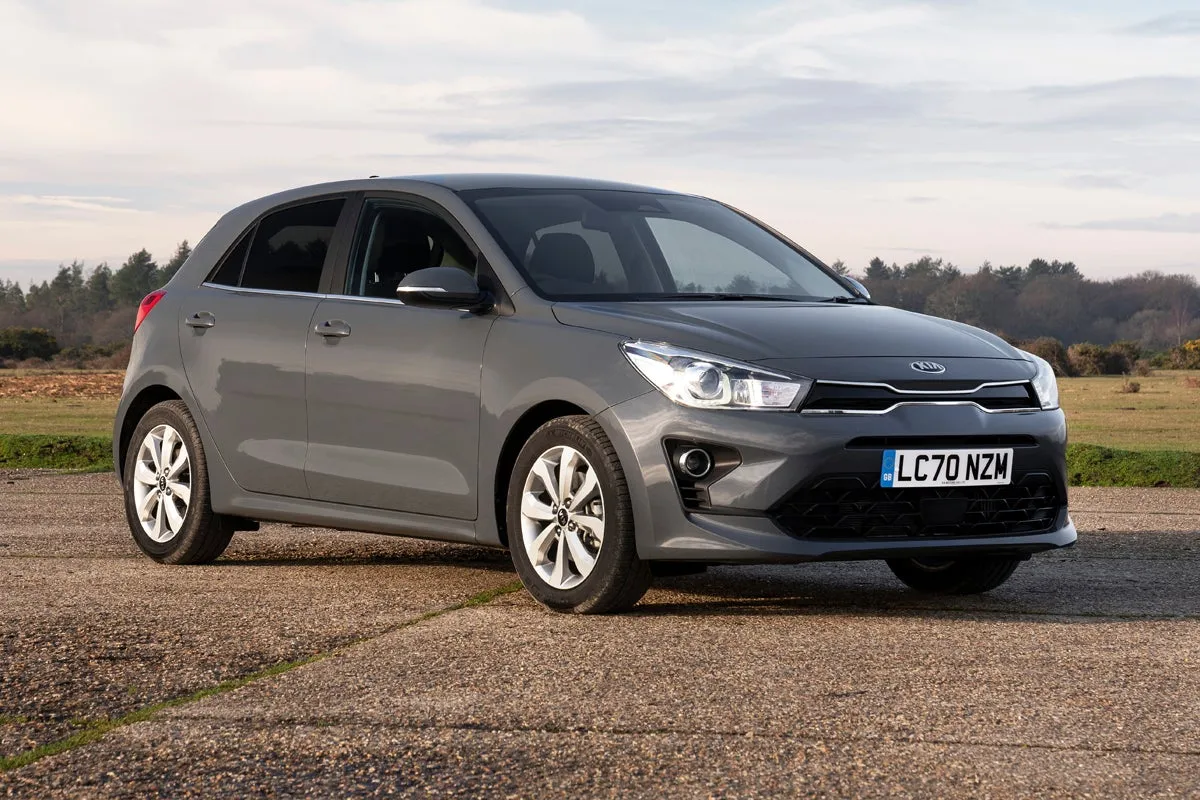
Does that make the Kia Rio a bit, well, boring? Perhaps, but that’s no bad thing when all you want is a very reliable, dependable and, well, sensible small car. The fact it comes with a superb warranty, good engines, plenty of equipment and keen used-car pricing (Kia no longer offers the Rio for sale as an all-new car) is all to the good as well. We'll explain all in our 2024 Kia Rio review.
Cost-effectiveness is at the core of the Rio’s being and economy is strong, with almost every engine officially capable of more than 60mpg. Go for a diesel when buying used and the claimed figures rise upwards of 80mpg, but the real highlight is the 1.0-litre T-GDI petrol. It’s punchy, quiet and economical whether you pick the 100PS version or the 120PS version.
The Kia Rio is very easy to drive, with light, smooth controls. Around town it’s good for the most part, but the suspension does have a tendency to thump over potholes. Fortunately, things get smoother and more comfortable at higher speeds, with good refinement on the motorway.
Inside, the Kia Rio is nicely finished, with sturdy build quality and a clear and intuitive layout. The centre stack features a responsive touchscreen system if you skip the basic ‘1’ trim level, while the dials are simple and easy to read. There’s plenty of adjustment in the driver’s seat, too.
The brand has also attempted to spritz up its Fiesta rival with the arrival of the Kia Rio GT Line in early 2018, followed by the Rio GT Line S. The GT Line comes with 17-inch alloy wheels, a gloss black and chrome grille treatment that Kia refers to as a ‘tiger nose’, and LED front lights. Okay, so it’s no hot hatch to take on the Ford Fiesta ST, but the GT Line does add a modicum of pizzazz to what is, we’ll grant you, a very worthy but somewhat dull line-up.
As small hatchbacks go, practicality is good. There’s enough space in the back for a couple of adults, with surprising levels of headroom and - unless there are tall occupants up front - decent legroom, too. The boot is sizeable with 325 litres of capacity, beating the Ford Fiesta and Volkswagen Polo.
It might not have the all-round classiness and capability of the SEAT Ibiza or the dynamic sparkle of the Ford Fiesta, but the Kia Rio is a very capable hatchback that does everything well enough. Factor in the seven-year warranty, and the Kia Rio is a sound used buy.
Looking for a used car for sale? We've got 100s of Kia Approved Used Cars for Sale for you to choose from, including a wide range of Kia Rio cars for sale.
Is the Kia Rio right for you?
To get a measure of how many people reckon the Kia Rio is just right for them, consider this: it’s the biggest-selling model of a company that is ranked third in the world for the number of cars it produces. Kia churns out Rios by the thousand and many people love them.
Why do they love them? Simple, really. The Kia Rio demands very little of its owner yet repays your trust in it with unerring reliability, ease of use and a level of equipment you’ll find hard to match for the money elsewhere in the supermini class.
The fact the Kia Rio is decent to drive, comfortable, refined, safe and has engines that are good to use all add to its appeal. So, if you are in the market for a Ford Fiesta, Vauxhall Corsa or Volkswagen Polo, stop and take stock of the Kia Rio. It might just be the car for you that you’ve just not yet considered.
What other cars are similar to the Kia Rio?
Kia’s biggest threat for the Kia Rio comes from its sister company Hyundai with its i20 that was introduced in mid-2020. Not only is it a newer car with improved tech, it also comes with a good warranty and is very good to drive.
In the supermini sector, you can never discard the Ford Fiesta, Vauxhall Corsa or Volkswagen Polo from your deliberations. You should also give thought to the Peugeot 208, SEAT Ibiza and Renault Clio, as well as the MINI and Audi A1 if you want something a bit posher.
Comfort and design: Kia Rio interior
"It may not be the last word in the style stakes, but there’s no doubting that the Kia Rio’s dashboard is very user-friendly. Big buttons and dials for the heating make it very easy to adjust while driving, and the 7.0-inch touchscreen that comes with most models is clear to read and it's easy to work your way through its menus."
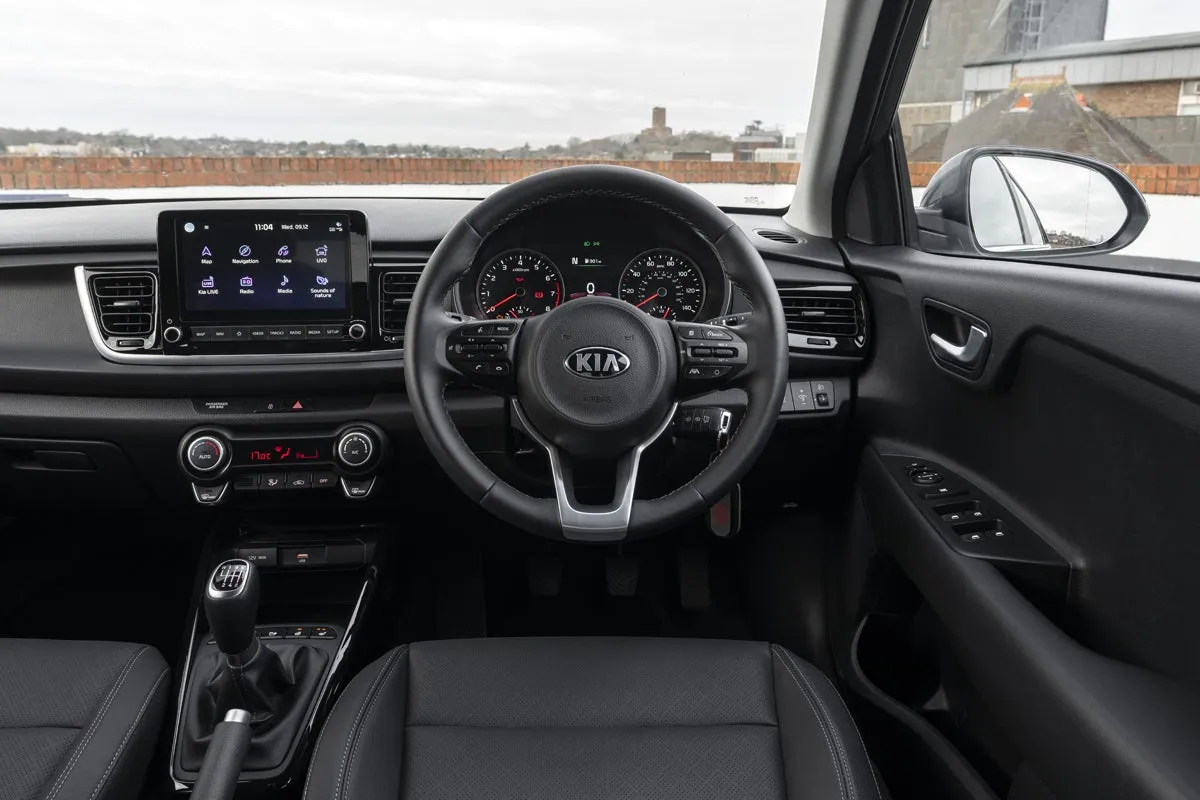
The main instrument panel is just as good, with the speedo and rev counter in the driver’s eye line as you glance down. Kia also provides plenty of storage for the driver and front passenger thanks to large door bins, a tray in front of the gear lever, twin cupholders and cubby between the front seats, and a reasonable glovebox.
Kia has made an excellent job of making the driver comfortable thanks to a supportive seat with height adjustment as standard on all models. There’s also reach- and angle movement for the steering wheel to further finesse the driving position, and on the 3 trim you also get a heated steering wheel for a touch of decadent luxury. Space isn’t a problem thanks to generous head-, leg- and elbow room.
The view from the driver’s seat is excellent to the front and sides, with little interruption to your sight lines from the windscreen pillars. Over-the-shoulder vision when changing lanes or reverse parking is less clear due the thick rear pillars, but it's on a par with most cars in this class. Only the Kia Rio GT Line S comes with a blind spot alert to address this issue.
Quality and finish
The difference between perceived quality and actual strength of construction is ably demonstrated inside the Kia Rio. At its launch in 2017, it was a little disappointing to note the cabin materials had not made a huge leap onwards from the car's predecessor, yet this criticism was aimed at the look and feel of them: there was zero doubt about their solidity.
Time has confirmed that the Kia Rio is, in fact, a very well constructed contender in the supermini class. It may not be the most stylish in terms of design or the textures and finishes used, but you can be assured they will put up with all the use and abuse that a family and kids can throw at them.
There are also very few of the rough edges that mar some of the Kia Rio’s big-name rivals on areas such as the door pockets or lower reaches of the seat bases. It all goes to prove that Kia has elevated the Rio’s build quality to a high standard, and also that we expect a lot from this manufacturer in terms of fit and finish, which it delivers.
Infotainment: Touchscreen, USB, nav and stereo in the Kia Rio
The entry-level Kia Rio 1 has a simple 3.8-inch display for its radio and comes with Bluetooth, four speakers, and USB and aux-in ports. It also has a 3.5-inch black and white display in the main instrument binnacle to show a range of driver information such as fuel economy and range.
Move to the Rio 2 and GT Line trims and you get upgraded to a 7.0-inch touchscreen with DAB digital radio included. This also gives you access to music via Apple CarPlay and Android Audio, while the same screen is also used for a reversing camera. Another improvement over the 1 trim is the Supervision display between the main dials.
With the Kia Rio 3 and GT Line S models, you get the full 7.0-inch touchscreen with navigation and Kia Connected Services that uses TomTom to provide information on traffic congestion, speed cameras, weather and to search local area information.
In all cases, the Rio’s 7.0-inch display has large on-screen icons and easy pairing with your smartphone. It’s not as simple to work as some rival systems, but it's good enough.
Space and practicality: Kia Rio boot space
Measuring 4065mm in length, 1725mm wide and 1450mm tall, the Kia Rio is one of the larger cars in its class and this pays dividends when it comes to accommodating passengers. The front passenger doesn’t have height adjustment for their seat, but they do get plenty of shoulder- and head room, and the seat slides back more than enough to let taller people stretch out.
Head into the back of the Kia Rio and access is good thanks to this supermini only being offered as a five-door. The flat cushion of the bench makes it easier to fit three people across the seat, and even a trio of adults will fit at a push on shorter trips. This is something few of the Rio’s rivals can achieve. One neat touch to note is the USB charger in the rear of all Rios other than the 1 trim.
Every Rio comes with a brace of ISOFIX child seat mounts in the back seats and there’s lots of room to fit a rear-facing baby seat. You also get three-point seat belts for all rear occupants. As for space, it’s good for two and they won’t need to rub shoulders, but legroom is more restricted, although still good by supermini standards.
The same can be said of the Kia Rio's boot capacity: it offers up 325 litres of cargo space to make it one of the more generous in the sector. Use the 60/40 split-and-tumble rear seat and you can open up the boot to a maximum of 1103 litres to make it one of the largest among superminis.
However, the boot is accessed over a high load sill with quite a drop to the load floor. Compounding this is the significant step created in the boot floor where the rear seats hinge forwards. However, at least the boot is deep thanks to there being no spare wheel. Instead, Kia supplies a tyre repair kit.
There’s a small storage box on the left-hand side of the Rio’s boot that is handy for storing small items like a bottle of de-icer and a scraper, so they are not rolling around on the floor.
Handling and ride quality: What is the Kia Rio like to drive?
"Superminis have to fulfil a multiplicity of roles and the Kia Rio does its best to cover all the bases, from urban runabout to long-distance cruiser. It doesn’t quite pull off everything as successfully as a Ford Fiesta or Volkswagen Polo, so you will have to put up with a firm ride around town that can leave you wishing for a bit more compliance as you negotiate yet another speed bump or adjust the steering to avoid a pothole."
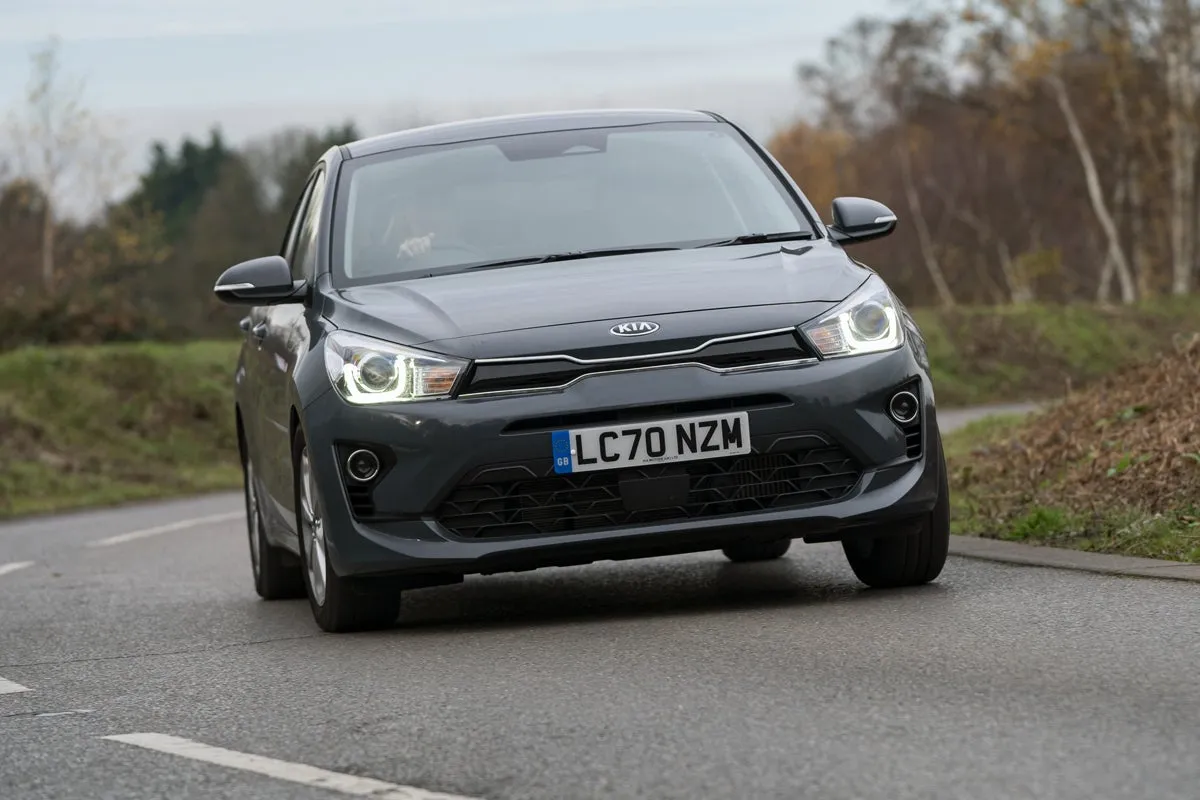
Head on to faster roads and the suspension’s firm edge turns into decent body control to make the Rio a much better car for cruising on the motorway. This set-up also gives it very good stability, even in crosswinds or when passing large trucks where the air blast can have some other small cars being blown about.
The firm ride at lower speeds is more obvious in Kia Rio GT Line models with their 17-inch alloy wheels that are standard. Go for the 1, 2 or 3 trims with their smaller wheel sizes and they cope better with the obstacles a typical street can throw at them. However, all of the Rio models are saddled with the same inert steering feel.
For most drivers, this won’t be a particular issue as the wheel is light to turn, making the Rio easy to park even in the narrowest of gaps. However, step out of a Ford Fiesta into a Kia Rio and you will miss that greater sense of control the Ford’s steering imparts.
It’s a similar story where handling is concerned. There’s nothing at all wrong with the safe, predictable nature of the Kia as it enters and exits a bend as it’s very sure-footed. It’s just that a Fiesta or MINI goes around corners with a bit more verve that means there’s always a bit of fun in the offing if you want it, whereas the Kia Rio is happy just to plot a course and leave the drama to other small hatches.
What engines and gearboxes are available in the Kia Rio?
The Kia Rio's engine line-up has changed a bit over the years. Initially, it was offered with three petrol engines - a 1.25-litre with 85PS, a 1.4 with 99PS and a turbocharged 1.0-litre three-cylinder with 100PS - plus a 1.4-litre CRDi diesel with 78PS.
The 1.25 motor comes with Intelligent Stop-Go tech to save fuel when the car would otherwise be idling when sat still in traffic, but that’s about as sophisticated as it gets. It has to be worked quite hard to get much decent acceleration out of it, which has the knock-on effect of making it quite noisy anywhere other than in town. Still, the five-speed manual has an easy shift action. The 1.4 is a little faster on paper, but it still feels rather strained and sluggish in the way it builds speed.
On that score, the turbocharged 1.0 T-GDI motor is much better. It only has a single horsepower more than the 1.25, but because it has three cylinders rather than four, it punches well above its weight when it comes to low-down shove. In fact, it’s 0-62mph time of 10.3 seconds is more than two seconds brisker than the 1.25’s. There’s a little more vibration when the 1.0-litre engine is ticking over, but this disappears the moment you touch the accelerator pedal. From then on, it pulls keenly to make town driving fun and offer safe overtaking on faster roads, as well as cruising quietly on the motorway.
We never got to drive the diesel version of the Rio. In October of 2020, both the diesel and the 1.4 petrol were binned, and a new version of the 1.0-litre turbo was introduced, with 120PS and mild hybrid technology. The extre power makes it feel a good bit perkier than the lower-powered version of the 1.0-litre, scrambling from 0-62mph around half a second quicker. When paired with a manual gearbox, this engine has an electronically actuated clutch that can feel clunky and remote, so for this reason, we could be tempted into a Rio with the seven-speed dual-clutch DCT automatic that has seamless, rapid shifts with very little detrimental effect on acceleration.
Refinement and noise levels
There is a clear division in the Kia Rio when discussing refinement and it comes right down to which engine you choose. Opt for the entry-point 1.25-litre MPI motor and you will have to accept it’s just not very quiet in operation.
Around town, the 1.25 does an okay job of ferrying its occupants around without making itself too noticeable. However, the moment you ask it to get a move on, this four-cylinder engine becomes coarse with too much row from under the bonnet.
Take either of the three-cylinder 1.0-litre turbo petrol motors and it’s a completely different story. They let you know of their cylinder count with a distinct aural burr on idle, but it’s a pleasant sound and smoothes out the moment you apply a few revs the engine. Wherever you drive these engines, they remain calm and easy on the ears. We only wish the six-speed manual gearbox in the more powerful 120PS version was a little less notchy in its action.
As for wind- and road noise, both are admirably well suppressed in the Kia’s cabin to make it one of the most hushed cars in the class. As such, it also makes the Rio one of the most capable when it comes to covering larger distances.
Safety equipment: How safe is the Kia Rio?
When it first came out, the Kia Rio was one of the most comprehensively kitted out cars in its class when it comes to standard safety tech. As well as the expected ESP stability control, ABS anti-lock brakes and tyre pressure monitoring system, you got six airbags and a Hill-start Assist to prevent the car rolling backwards when driving off up an incline.
As well as this lot, every Kia Rio came with three-point seat belts for all five occupants and a pair of Isofix child seat mounts for the two outer rear seats. Choose any Rio other than the base 1 trim, and Kia included autonomous emergency braking to instantly apply the brakes if the car senses the driver has not reacted to a potential danger in the road ahead, along with Lane Keeping Assist. These features are usually standard across the board on most of today's newer car, but back then, it wasn't unusual for entry-level variants to miss out on this important safety tech.
Again, every Rio except the 1 has a reversing camera and rear parking sensors. It’s a pity neither of these is an option for the 1 model.
Without key safety-enhancing features, the 1-trimmed Rio only managed a three-star score in Euro NCAP tests, but that improves to a full five-star rating for all other versions, with impressive showings for adult and child occupant safety.
MPG and fuel costs: What does a Kia Rio cost to run?
"From the range of petrol engines in the Kia Rio, the 100PS 1.0 T-GDI is the most economical thanks to its official combined figure of 48.7mpg under WLTP testing. This is helped by all Rios with a manual gearbox using Intelligent Stop and Go technology to switch off the engine when the car is stationary. Using Real MPG figures, this engine delivers 46.1mpg."
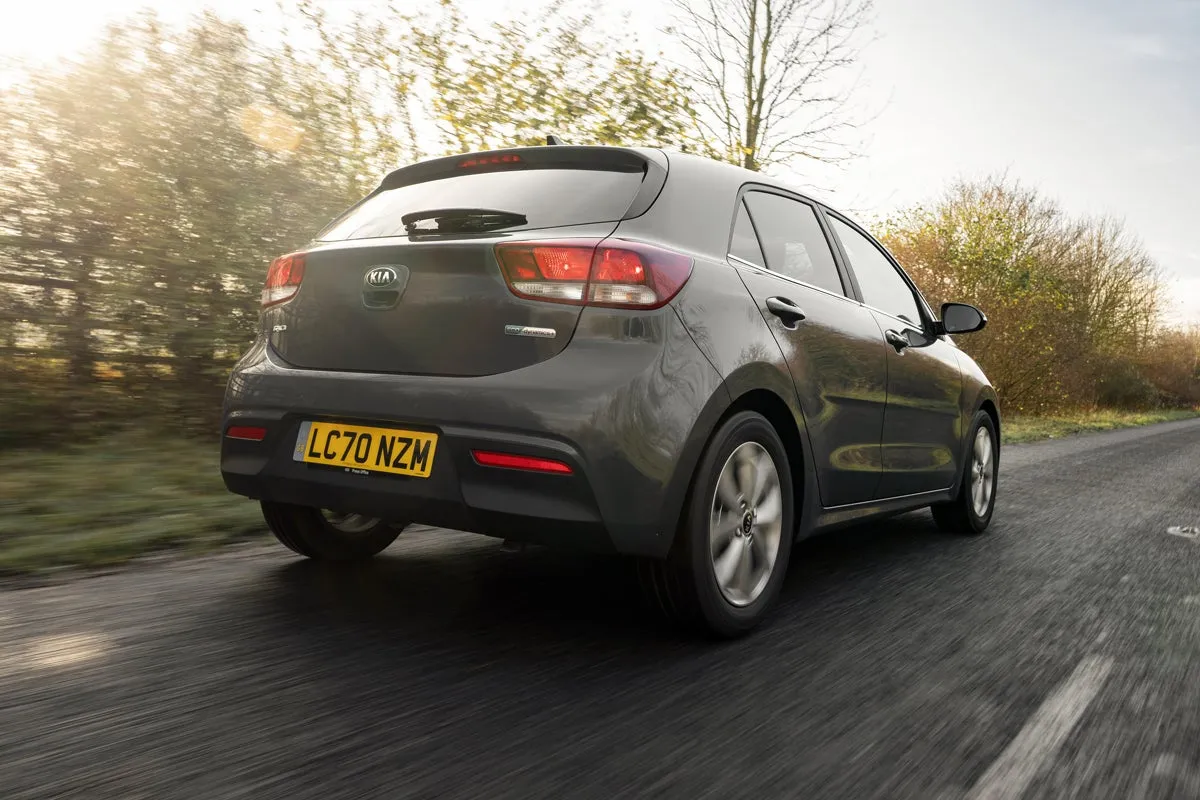
If you want a diesel-powered Rio, a 1.4-litre CRDi model gives a Real MPG figure of 66.3mpg to get within 88 per cent of its claimed official average consumption of 78.5mpg.
How reliable is a Kia Rio?
The Kia Rio punches well above its weight in terms of reliability. Indeed, we'd say it's much less likely to let you down than a more mainstream competitor like the Vauxhall Corsa or Ford Fiesta.
As a brand, Kia ranked highly in the 2023 HonestJohn.co.uk Satisfaction Index. Out of the 29 manufacturers considered, it placed 7th in the reliability standings, and 8th for overall owner satisfaction. The transferable seven-year, 100,000-mile warranty should put you at ease, too.
Insurance groups and costs
Regardless of which model Kia Rio you pick, none of them are going to upset your bank balance much when it comes to insurance premiums. Oddly, the entry-point 1 attracts a group 6 rating where the 2 version with the same 1.25-litre petrol engine sits in the more affordable group 4.
Choose the 100PS 1.0-litre engine and it is ranked in group 8 regardless of trim level, while the more potent 120PS 1.0-litre motor sits in group 9 in GT Line form. Take the GT Line S and it edges into group 10.
VED car tax: What is the annual road tax on a Kia Rio?
On April 1st of 2017, the VED road tax laws changes. Before this date, you were taxed in accordance to the CO2 emissions of your car, while afterwards, buyers of regular petrol and diesel cars paid a flat rate of £180 regardless of emissions.
The Rio was first introduced in February of that year, so if you can find one of the very first examples that was registered before the cutoff date, you can make some useful savings. Thanks t their low CO2, some diesel models require an annual payment of just £20, while others are exempt entirely. Pretty much all the petrol from that time will be liable for the same £180 annual bill as all variant from after the cutoff date, and that's as much as you'll pay on any Rio.
How much should you be paying for a used Kia Rio?
"A browse through our listings reveals that the cheapest Rios can be had for around £8,000-9,000. These are early examples from 2017 or 2018, with moest engines and trim levels, with usually around 50,000 miles on the clock."
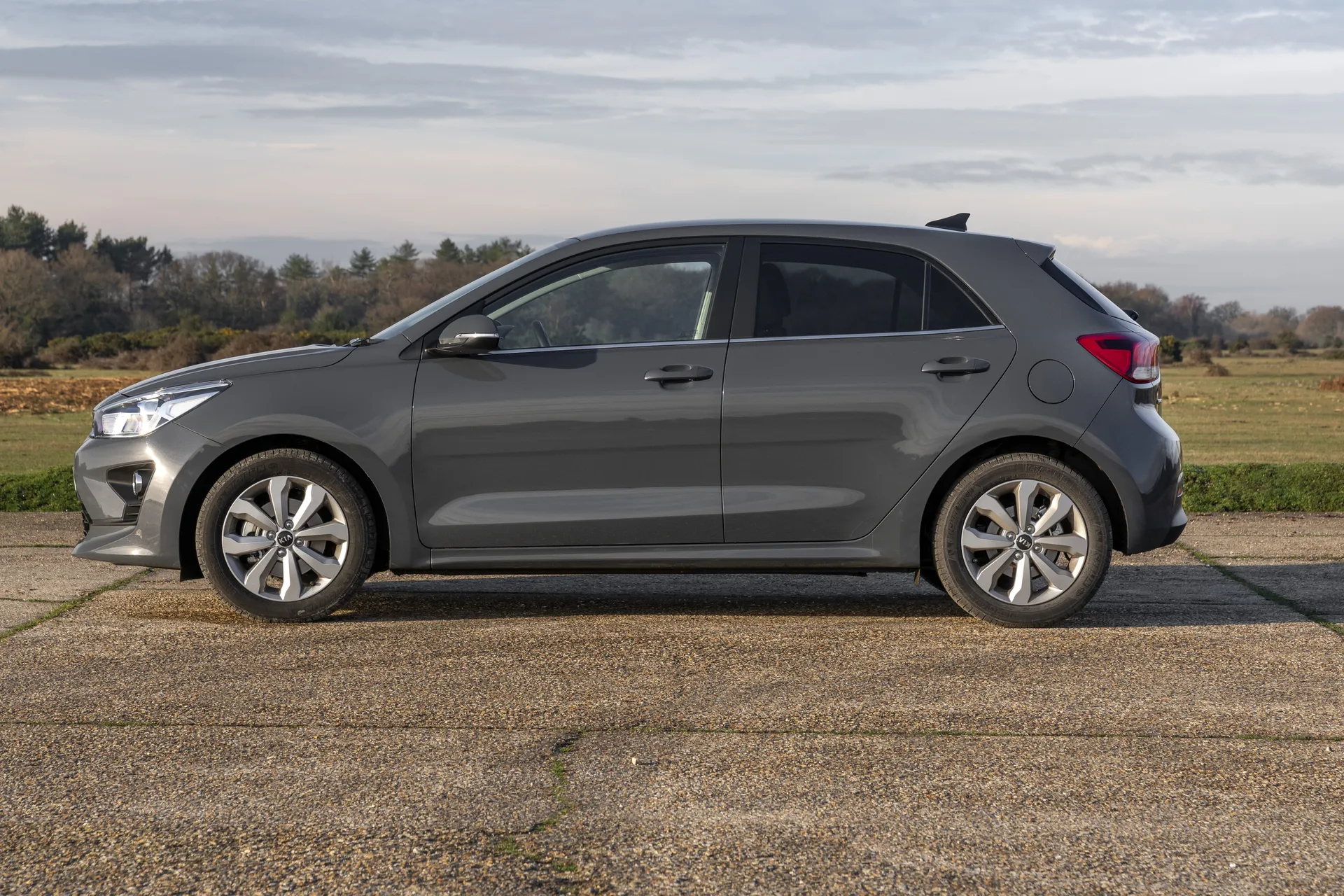
If you can raise your budget to around around £12,000-13,000, you'll be looking at a car of a similar spec, but with a lower mileage, and that's only three years old. That's important, because Kia's impressive warranty means these cars could still have four years of cover left, which is more than you get on most brand new cars.
And speaking of brand new cars, Kia Rio buyers no longer have this option because the Korean firm has stopped selling it as a brand new model in the UK. All the more reason to enjoy the discounts that the used car market has to offer.
Trim levels and standard equipment
Kia keeps it simple and starts the line-up with the Rio 1 trim. It sits on 15-inch steel wheels and has plain black cloth upholstery. You get driver’s seat height adjustment, air conditioning, electric front windows and a 3.8-inch black and white infotainment display with Bluetooth connection.
A better bet is the Kia Rio 2, with 15-inch alloy wheels and gloss black exterior detailing, rear parking sensors, and daytime running lights. Inside, there’s Premium Black Cloth for the seats, a leather-bound steering wheel, electric windows all round, cruise control, and the 7.0-inch infotainment touchscreen with reversing camera.
On top of this, the 3 gains 16-inch alloys, rain-sensing wipers and faux leather upholstery with heated front seats and steering wheel. Automatic air conditioning and infotainment with navigation and Kia Connected Services with TomTom updates for traffic and speed cameras completes the list.
Then there’s the Kia Rio GT Line that was introduced later. This is based on the 2 model but with 17-inch alloys, ‘Ice-cube’ design LED headlights, and twin exhaust pipes for a sportier look. Half-leather-trimmed seats, flat-bottom steering wheel and carbon-effect trim inserts lift the interior feel. Choose the Rio GT Line S and you get all of this mixed with the luxury kit of the 3 trim.
Ask the heycar experts: common questions
Is the Kia Rio a good, reliable car?
Which is better: the Kia Rio or Hyundai i20?
Has the Kia Rio been discontinued?
Get our latest advice, news and offers
Keep me updated by email with the latest advice, news and offers from heycar.
By submitting you agree to our privacy policy
